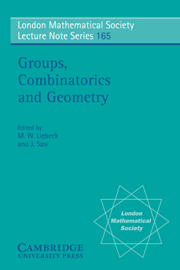Book contents
- Frontmatter
- Contents
- Authors' Addresses
- Introduction
- Part 1 Sporadic groups
- Part 2 Moonshine
- Part 3 Local and geometric methods in group theory
- Part 4 Geometries and related groups
- Part 5 Finite and algebraic groups of Lie type
- 22 Some remarks on the structure of finite subgroups of simple algebraic groups
- 23 Some (almost) multiplicity-free coset actions
- 24 Orbits in internal Chevalley modules
- 25 Subgroups of finite and algebraic groups
- 26 Irreducible representations of finite Chevalley groups containing a matrix with a simple spectrum
- 27 Overgroups of unipotent elements in simple algebraic groups
- Part 6 Finite permutation groups
- Part 7 Further aspects of simple groups
- Part 8 Related topics
22 - Some remarks on the structure of finite subgroups of simple algebraic groups
Published online by Cambridge University Press: 07 September 2010
- Frontmatter
- Contents
- Authors' Addresses
- Introduction
- Part 1 Sporadic groups
- Part 2 Moonshine
- Part 3 Local and geometric methods in group theory
- Part 4 Geometries and related groups
- Part 5 Finite and algebraic groups of Lie type
- 22 Some remarks on the structure of finite subgroups of simple algebraic groups
- 23 Some (almost) multiplicity-free coset actions
- 24 Orbits in internal Chevalley modules
- 25 Subgroups of finite and algebraic groups
- 26 Irreducible representations of finite Chevalley groups containing a matrix with a simple spectrum
- 27 Overgroups of unipotent elements in simple algebraic groups
- Part 6 Finite permutation groups
- Part 7 Further aspects of simple groups
- Part 8 Related topics
Summary
This paper is a survey of some results by the author in the study of the subgroup structure of the finite simple groups of Lie type. Throughout the paper G is a simple algebraic group; if G is denned over a finite field Fq then σ is some Steinberg endomorphism of G. We shall omit index G in notations like NG(X), CG(X).
Subgroups of simple groups of exceptional type.
The first result of the paper is a reduction theorem for the maximal subgroups of finite exceptional groups similar to the well-known result of M. Aschbacher for finite classical groups. In the case of classical groups Theorem 1 doesn't give any new information, but it may be useful in the study of simple groups of exceptional type. Another and more explicit version of a reduction theorem was obtained recently by M. W. Liebeck and G. M. Seitz.
Theorem 1Let G be defined over the finite field Fq, Gσ ≅ G(Fq) and. Let G0 ≤ G1 ≤ Aut G0and let M be a subgroup in G1. Then one of the following statements is valid:
(a) for some proper connected nontrivial σ-invariant subgroup H ≤ G;
(b) M is an almost simple group, i.e. S ≤ M ≤ Aut S for some simple group S;
(c) M ≤ NG(J) for some Jordan subgroup J in G;
(d) G is of type E8, charFq = p > 5 and M ≤ NGl(X), where X ≅ Alt5 × Alt6.
- Type
- Chapter
- Information
- Groups, Combinatorics and Geometry , pp. 287 - 291Publisher: Cambridge University PressPrint publication year: 1992
- 1
- Cited by

